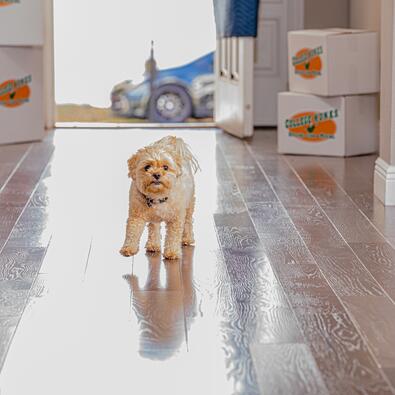
How to Remove Carpeting
Carpeting is one of those items in our homes we enjoy, but as time passes and foot traffic takes its toll on the floor, it really begins to show wear and quickly loses its appeal. What's more is no matter how often we vacuum or shampoo our carpets, over time, the carpet itself and the pad underneath can accumulate years of dust, dirt, and other debris. For those who struggle with allergies in particular, carpets are like a repository of allergy-inducing particles that need to be taken out.
Anatomy of a Carpet
Your carpet is an entire system of components which work together to keep it in place and keep it looking great for years. When any number of these elements start to wear out or fail is when carpets need to be replaced or removed entirely.
- The carpet: The carpet is the fabric everyone sees. It consists of layers of backing which is stitched with tens of thousands of fibers called "piles" and glued into place which constitute the "face" of the carpet. The depth of the face is what gives the carpet that soft and springy texture. It is usually, made from wool, nylon, or other fibers.
- The carpet pad: This is a layer of foam that goes between the carpet and the subflooring. It helps reduce noise, make the carpet softer, and provides volume to the carpet face by absorbing impact and weight.
- Carpet tack strips: These are strips of wood that are nailed to the subflooring at the edges of the room as well as thresholds, steps, and other transitional areas. They have a series of upward facing tacks which dig into the carpet backing to hold it in place under tension. The carpet is stretched and set into place on the tacks to eliminate lumps and inconsistencies.
Step By Step Carpet Removal
It is important to use the proper tools and safety equipment to remove carpet. The tack strip can poke or cut your skin, so be sure to wear sturdy work gloves, canvas pants, and other protective clothing to avoid injury. Since you will be cutting carpet it is also highly recommended to observe knife safety while working. Due to the amount of dust trapped in the carpet and carpet pad, eye protection as well as a filter facemask is also recommended.
Let's get started!
- Pick a corner and use pliers to pull up the carpet. It should pop loose from the tacks.
- Detach the remaining carpet from the tack strip by pulling up on the carpet, following the line of the tack strip along the wall.
- Use a utility knife to cut the carpet into smaller and more manageable strips.
- Walk back from the corner while holding the carpet to detach it from the floor, being careful to not step on any exposed tack strips.
- Roll carpeting and carpet pad. This can be done together or separately as needed.
- Secure the rolls with twine or duct tape and remove them from the area.
- If you are removing the carpet tack strips, use a small prybar and gently lift up on the carpet tack strips to remove.
- If adhesive was used a sharper scraping tool may be needed to scrape off the glue and separate it from the carpeting.
What to do with the removed carpeting, backing, and tack strip
Contact your trash removal company, recycling center, or local landfill to dispose of the rolled carpet. Likely you will be charged a fee for disposal and need to arrive only on certain days or times. Tack strips need to be secured in appropriate bags or boxes, since they will likely poke right through typical garbage bags. You will probably have to use your own vehicle to transport it to the center or dump. If you remove large amounts of carpeting this can take multiple trips.
Or you can call College HUNKS to haul it away! We specialize in hauling away your junk, renovation waste materials, and all sorts of other waste. Cheaper and more convenient than a dumpster, we offer friendly and reliable service for same day or scheduled pick-ups. Some of our service packages also include minor demolition work, so you can ignore all the steps in removing carpet if you hire us to do it.
Our no-surprise pricing means that with a free estimate, we won't move anything until you know how much the job will cost. Our pricing is determined by volume so you aren’t locked in to one, large disposal fee. Because we partner with non-profits, local recyclers, and other organizations, our goal is to recycle or repurpose the junk we collect--upwards of 70% or more! We pass the savings onto our customers as well as keeping a lot of junk out of our landfills.
